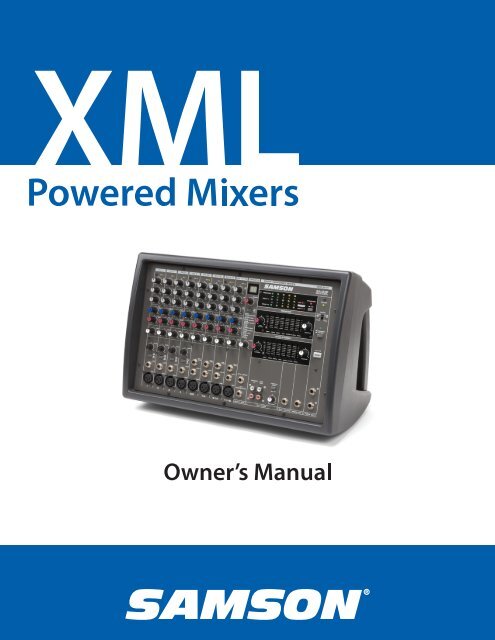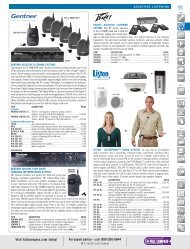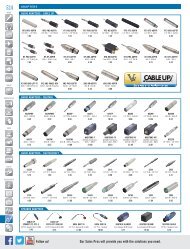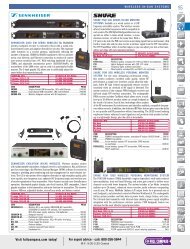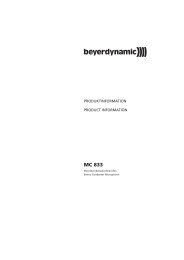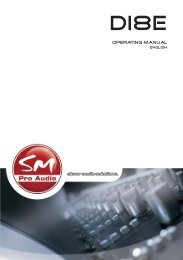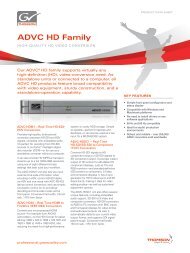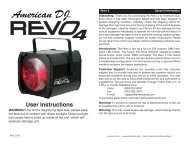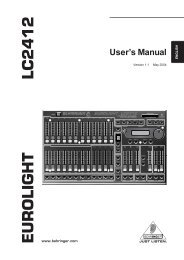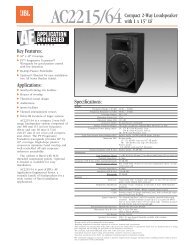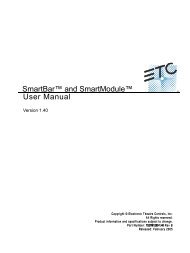Download the XML410 English User Manual in PDF format - Samson
Download the XML410 English User Manual in PDF format - Samson
Download the XML410 English User Manual in PDF format - Samson
Create successful ePaper yourself
Turn your PDF publications into a flip-book with our unique Google optimized e-Paper software.
Important Safety In<strong>format</strong>ion<br />
AVIS<br />
RISQUE DE CHOC ÉLECTRONIQUE -<br />
NE PAS OUVRIR<br />
CAUTION: TO REDUCE THE RISK OF ELECTRIC SHOCK, DO NOT<br />
REMOVE COVER (OR BACK). NO USER-SERVICEABLE PARTS IN-<br />
SIDE. REFER SERVICING TO QUALIFIED SERVICE PERSONNEL.<br />
This lightn<strong>in</strong>g flash with arrowhead symbol with<strong>in</strong> an equilateral triangle is<br />
<strong>in</strong>tended to alert <strong>the</strong> user to <strong>the</strong> presence of non-<strong>in</strong>sulated “dangerous voltage”<br />
with<strong>in</strong> <strong>the</strong> product’s enclosure that may be of sufficient magnitude to<br />
constitute a risk of electric shock.<br />
The exclamation po<strong>in</strong>t with<strong>in</strong> an equilateral triangle is <strong>in</strong>tended to alert <strong>the</strong><br />
user to <strong>the</strong> presence of important operat<strong>in</strong>g and ma<strong>in</strong>tenance <strong>in</strong>structions<br />
<strong>in</strong> <strong>the</strong> literature accompany<strong>in</strong>g <strong>the</strong> appliance.<br />
If you want to dispose this product, do not mix it with general household waste. There is a<br />
separate collection system for used electronic products <strong>in</strong> accordance with legislation that<br />
requires proper treatment, recovery and recycl<strong>in</strong>g.<br />
Private household <strong>in</strong> <strong>the</strong> 25 member states of <strong>the</strong> EU, <strong>in</strong> Switzerland and Norway may return <strong>the</strong>ir used<br />
electronic products free of charge to designated collection facilities or to a retailer (if you purchase a similar<br />
new one).<br />
For Countries not mentioned above, please contact your local authorities for a correct method of disposal.<br />
By do<strong>in</strong>g so you will ensure that your disposed product undergoes <strong>the</strong> necessary treatment, recovery and<br />
recycl<strong>in</strong>g and thus prevent potential negative effects on <strong>the</strong> environment and human health.
1. Read <strong>the</strong>se <strong>in</strong>structions.<br />
2. Keep <strong>the</strong>se <strong>in</strong>structions.<br />
3. Heed all warn<strong>in</strong>gs.<br />
4. Follow all <strong>in</strong>structions.<br />
Important Safety In<strong>format</strong>ion<br />
5. This apparatus shall not be exposed to dripp<strong>in</strong>g or splash<strong>in</strong>g liquid and no object filled with liquid, such as a vase,<br />
should be placed on <strong>the</strong> apparatus.<br />
6. Clean only with a dry cloth.<br />
7. Do not block any of <strong>the</strong> ventilation open<strong>in</strong>gs. Install <strong>in</strong> accordance with <strong>the</strong> manufacturer's <strong>in</strong>structions.<br />
8. Do not <strong>in</strong>stall near any heat sources such as radiators, heat registers, stoves, or o<strong>the</strong>r apparatuses (<strong>in</strong>clud<strong>in</strong>g amplifiers)<br />
that produce heat.<br />
9. Only use attachments/accessories specified by <strong>the</strong> manufacturer.<br />
10. Unplug this apparatus dur<strong>in</strong>g lightn<strong>in</strong>g storms or when not <strong>in</strong> use for long periods of time.<br />
11. Do not override <strong>the</strong> <strong>in</strong>tended purpose of <strong>the</strong> polarized or ground<strong>in</strong>g-type plug. A polarized plug has two blades, with<br />
one wider than <strong>the</strong> o<strong>the</strong>r. A ground<strong>in</strong>g-type plug has two blades and a third ground<strong>in</strong>g prong. The wide blade, or<br />
third prong, is provided for your safety. If <strong>the</strong> provided plug does not fit your outlet, consult an electrician to replace<br />
<strong>the</strong> obsolete outlet.<br />
12. Protect <strong>the</strong> power cord from be<strong>in</strong>g walked on or p<strong>in</strong>ched, particularly at <strong>the</strong> prongs, convenience receptacles, <strong>the</strong><br />
po<strong>in</strong>t where <strong>the</strong>y exit from <strong>the</strong> apparatus.<br />
13. Use only with <strong>the</strong> cart stand, tripod bracket, or table specified by <strong>the</strong> manufacture, or sold with <strong>the</strong><br />
apparatus. When a cart is used, utilize caution when mov<strong>in</strong>g <strong>the</strong> cart/apparatus comb<strong>in</strong>ation to<br />
avoid <strong>in</strong>jury from tip-over.<br />
14. Refer all servic<strong>in</strong>g to qualified service personnel. Servic<strong>in</strong>g is required if <strong>the</strong> apparatus has been<br />
damaged <strong>in</strong> any way, such as power-supply cord or plug breakage, damage due to liquid or objects<br />
fall<strong>in</strong>g onto <strong>the</strong> apparatus, exposure to ra<strong>in</strong> or moisture, or if <strong>the</strong> apparatus does not operate normally, or has been<br />
dropped.<br />
15. POWER ON/OFF SWITCH: For products with a power switch, <strong>the</strong> power switch DOES NOT break <strong>the</strong> connection from<br />
<strong>the</strong> ma<strong>in</strong>s.<br />
16. MAINS DISCONNECT: The plug should rema<strong>in</strong> readily operable. For rack-mount or <strong>in</strong>stallation where plug is not accessible,<br />
an all-pole ma<strong>in</strong>s switch with a contact separation of at least 3mm <strong>in</strong> each pole shall be <strong>in</strong>corporated <strong>in</strong>to<br />
<strong>the</strong> electrical <strong>in</strong>stallation of <strong>the</strong> rack or build<strong>in</strong>g.<br />
17. FOR UNITS EQUIPPED WITH EXTERNALLY ACCESSIBLE FUSE RECEPTACLE: Replace fuse with same type and rat<strong>in</strong>g<br />
only.<br />
18. MULTIPLE-INPUT VOLTAGE: This equipment may require <strong>the</strong> use of a different l<strong>in</strong>e cord, attachment plug, or both,<br />
depend<strong>in</strong>g on <strong>the</strong> available power source at <strong>in</strong>stallation. Connect this equipment only to <strong>the</strong> power source <strong>in</strong>dicated<br />
on <strong>the</strong> equipment rear panel. To reduce <strong>the</strong> risk of fire or electric shock, refer servic<strong>in</strong>g to qualified service personnel<br />
or equivalent.
Table of Contents<br />
Introduction. . . . . . . . . . . . . . . . . . . . . . . . . . . . . . . . . . . . . . . . . . . . . . . . . . . . . . . . 5<br />
XML Features . . . . . . . . . . . . . . . . . . . . . . . . . . . . . . . . . . . . . . . . . . . . . . . . . . . . . . . 6<br />
Controls and Functions Input Channel Section . . . . . . . . . . . . . . . . . . . . . . . . . . . . . . . . . 7<br />
Controls and Functions 24-Bit Digital Effects Section . . . . . . . . . . . . . . . . . . . . . . . . . . . . . 9<br />
Controls and Functions Ma<strong>in</strong> Section . . . . . . . . . . . . . . . . . . . . . . . . . . . . . . . . . . . . . . 10<br />
Controls and Functions External Input Jacks (AUX IN and CD/TAPE IN) . . . . . . . . . . . . . . . . . 12<br />
Controls and Functions External Output Jacks. . . . . . . . . . . . . . . . . . . . . . . . . . . . . . . . . 13<br />
Controls and Functions Power Amp Section . . . . . . . . . . . . . . . . . . . . . . . . . . . . . . . . . . 14<br />
Speaker Outputs - XML610 & XML910 . . . . . . . . . . . . . . . . . . . . . . . . . . . . . . . . . . . . . . 15<br />
Speaker Outputs - <strong>XML410</strong> . . . . . . . . . . . . . . . . . . . . . . . . . . . . . . . . . . . . . . . . . . . . . 16<br />
XML Series Rear Panel . . . . . . . . . . . . . . . . . . . . . . . . . . . . . . . . . . . . . . . . . . . . . . . . 17<br />
Speaker Connection - XML610 & XML910 . . . . . . . . . . . . . . . . . . . . . . . . . . . . . . . . . . . . 18<br />
Speaker Connection - <strong>XML410</strong> . . . . . . . . . . . . . . . . . . . . . . . . . . . . . . . . . . . . . . . . . . . 19<br />
Basic Operation . . . . . . . . . . . . . . . . . . . . . . . . . . . . . . . . . . . . . . . . . . . . . . . . . . . . 20<br />
Us<strong>in</strong>g <strong>the</strong> Internal Digital Effects . . . . . . . . . . . . . . . . . . . . . . . . . . . . . . . . . . . . . . . . . . 21<br />
Creat<strong>in</strong>g a Monitor Mix . . . . . . . . . . . . . . . . . . . . . . . . . . . . . . . . . . . . . . . . . . . . . . . . 22<br />
Us<strong>in</strong>g an External Effect . . . . . . . . . . . . . . . . . . . . . . . . . . . . . . . . . . . . . . . . . . . . . . . 23<br />
CD/TAPE IN • REC OUT . . . . . . . . . . . . . . . . . . . . . . . . . . . . . . . . . . . . . . . . . . . . . . . . 24<br />
XML System Setups . . . . . . . . . . . . . . . . . . . . . . . . . . . . . . . . . . . . . . . . . . . . . . . . . . 25<br />
XML610 & XML910 Specifications . . . . . . . . . . . . . . . . . . . . . . . . . . . . . . . . . . . . . . . . . 28<br />
<strong>XML410</strong> Specifications . . . . . . . . . . . . . . . . . . . . . . . . . . . . . . . . . . . . . . . . . . . . . . . . 29<br />
XML610 & XML910 Block Diagram. . . . . . . . . . . . . . . . . . . . . . . . . . . . . . . . . . . . . . . . . 30<br />
<strong>XML410</strong> Block Diagram. . . . . . . . . . . . . . . . . . . . . . . . . . . . . . . . . . . . . . . . . . . . . . . . 31<br />
Copyright 2010, <strong>Samson</strong> Technologies Corp.<br />
v1<br />
<strong>Samson</strong> Technologies Corp.<br />
45 Gilp<strong>in</strong> Avenue<br />
Hauppauge, New York 11788-8816<br />
Phone: 1-800-3-SAMSON (1-800-372-6766)<br />
Fax: 631-784-2201<br />
www.samsontech.com
Thank you for purchas<strong>in</strong>g <strong>the</strong> <strong>Samson</strong> <strong>XML410</strong>, XML610, or XML910 powered mixer.<br />
Introduction<br />
The <strong>XML410</strong> and XML610/910 are six- and twelve-channel, 400, 600 and 900 Watt powered mixers<br />
with built-<strong>in</strong>, 24-bit Digital Signal Processor (DSP) effects. The XML series of mixers will give you clean,<br />
clear sound reproduction thanks to <strong>the</strong> high quality, low noise microphone preamps, super clean mix<br />
bus, on-board 7-band graphic equalizers and <strong>the</strong> high output/low distortion power amplifier. For studio<br />
quality process<strong>in</strong>g, you can add one of <strong>the</strong> 100 dazzl<strong>in</strong>g digital effects (<strong>in</strong>clud<strong>in</strong>g Delays, Chorus<br />
and lush Reverbs) to your voice or <strong>in</strong>struments. The mixer’s <strong>in</strong>genious Kickback enclosure allows you<br />
to tilt <strong>the</strong> unit back to see and operate <strong>the</strong> controls with ease. The unit is easy to transport with its<br />
compact size and sure-grip handle. The super-tough construction ensures reliable sound from venue<br />
to venue, day <strong>in</strong> and day out. Optimized for live sound re<strong>in</strong>forcement and commercial <strong>in</strong>stallations,<br />
<strong>the</strong> XML series is an ideal mixer and power amp solution, provid<strong>in</strong>g big sound <strong>in</strong> a compact package.<br />
In <strong>the</strong>se pages, you’ll f<strong>in</strong>d a detailed description of <strong>the</strong> features of <strong>the</strong> XML series of powered mixers,<br />
as well a description of <strong>the</strong>ir front and rear panels, step-by-step <strong>in</strong>structions for setup and use, and<br />
full specifications. You’ll also f<strong>in</strong>d a warranty card enclosed—please don’t forget to fill it out and mail<br />
it <strong>in</strong> so that you can receive onl<strong>in</strong>e technical support and so that we can send you updated <strong>in</strong><strong>format</strong>ion<br />
about <strong>the</strong>se and o<strong>the</strong>r <strong>Samson</strong> products <strong>in</strong> <strong>the</strong> future.<br />
With proper care and adequate air circulation, your unit will operate trouble-free for many years. We<br />
recommend you record your serial number <strong>in</strong> <strong>the</strong> space provided below for future reference.<br />
Serial number: ____________________________________________<br />
Date of purchase: __________________________________________<br />
Should your unit ever require servic<strong>in</strong>g, a Return Authorization number (RA) must be obta<strong>in</strong>ed before<br />
shipp<strong>in</strong>g your unit to <strong>Samson</strong>. Without this number, <strong>the</strong> unit will not be accepted. Please call <strong>Samson</strong><br />
at 1-800-3SAMSON (1-800-372-6766) for an RA number prior to shipp<strong>in</strong>g your unit. Please reta<strong>in</strong> <strong>the</strong><br />
orig<strong>in</strong>al pack<strong>in</strong>g materials and, if possible, return <strong>the</strong> unit <strong>in</strong> <strong>the</strong> orig<strong>in</strong>al carton and pack<strong>in</strong>g materials.<br />
If you purchased your <strong>Samson</strong> product outside <strong>the</strong> United States, please contact your local<br />
distributor for warranty <strong>in</strong><strong>format</strong>ion and service.<br />
Owner's <strong>Manual</strong> XML POWERED MIXERS<br />
5
XML Features<br />
The <strong>Samson</strong> XML powered mixers are comprehensive, all-<strong>in</strong>-one mixer/power amplifier solutions for<br />
live sound applications. Here are some of <strong>the</strong>ir ma<strong>in</strong> features:<br />
• The <strong>XML410</strong> and XML610/910 are six- and twelve-channel powered mixers <strong>in</strong> ergonomically correct<br />
kickback enclosures, allow<strong>in</strong>g you to easily see and operate <strong>the</strong> front panel functions.<br />
• The <strong>XML410</strong> has six Mic/L<strong>in</strong>e <strong>in</strong>puts, while <strong>the</strong> XML610/910 has four Mic/L<strong>in</strong>e <strong>in</strong>puts plus four<br />
Stereo <strong>in</strong>puts with Mic preamplifiers.<br />
• The XML series of mixers possess ultra lightweight, high efficiency class-D amplifier design<br />
<strong>XML410</strong>: 2 x 200 Watts, or 400 Watts Bridged<br />
XML610: 2 x 300 Watts<br />
XML910: 2 x 450 Watts<br />
• A built-<strong>in</strong>, 24-bit Digital Signal Processor (DSP) with 100 selectable presets <strong>in</strong>clud<strong>in</strong>g Reverb, Delay,<br />
and Chorus, offers dazzl<strong>in</strong>g studio quality effects.<br />
• Dynamic or condenser microphones connect easily to <strong>the</strong> low noise mic pre-amps with available<br />
48 Volt Phantom Power.<br />
• The 3-Band EQ on each channel enables you to tailor <strong>the</strong> tonal response for each <strong>in</strong>put.<br />
• Each channel has two Auxiliary sends, which can be used to build an <strong>in</strong>dependent mix to send to<br />
<strong>the</strong> DSP effects and/or monitors.<br />
• The <strong>XML410</strong> features a 7-band Graphic Equalizer for <strong>the</strong> Ma<strong>in</strong> Mix, and <strong>the</strong> XML610/910 features<br />
dual 7-band Graphic Equalizer for operat<strong>in</strong>g <strong>in</strong> ei<strong>the</strong>r Stereo Ma<strong>in</strong>, or Ma<strong>in</strong>/Monitor, enabl<strong>in</strong>g<br />
adjustment to <strong>the</strong> tonal characteristics of <strong>the</strong> signal.<br />
• A convenient CD/MP3/Tape Input is provided so you can connect a stereo device for accompaniment<br />
or background music.<br />
• Durable plastic enclosure is road tough, ensur<strong>in</strong>g reliable performance.<br />
• Two convenient oversize, sure grip handles make <strong>the</strong> unit easy to carry.<br />
6<br />
XML POWERED MIXERS
Input Channel Section<br />
The follow<strong>in</strong>g section details each part of <strong>the</strong> XML’s INPUT CHANNELS <strong>in</strong>clud<strong>in</strong>g <strong>the</strong> 3-BAND EQ, <strong>the</strong> MONITOR and EFX<br />
sends, GAIN and VOLUME controls.<br />
1. Peak - This LED <strong>in</strong>dicator will flash RED when <strong>the</strong> channel <strong>in</strong>put signal peaks.<br />
To reduce distortion, turn <strong>the</strong> VOL control counterclockwise until <strong>the</strong> clip<br />
<strong>in</strong>dicator does not light dur<strong>in</strong>g normal use.<br />
2. Equalizer (HF, MF, and LF) - This three-band equalizer allows you to contour<br />
a channel’s high, mid, and low frequency bands. When <strong>the</strong> control is set to<br />
<strong>the</strong> 12 o'clock (detent) position, <strong>the</strong>re is no effect on <strong>the</strong> signal. Turn<strong>in</strong>g <strong>the</strong><br />
controls fully clockwise will raise <strong>the</strong> level of <strong>the</strong> frequency band +15 dB,<br />
while turn<strong>in</strong>g <strong>the</strong> controls fully counterclockwise will lower <strong>the</strong> level of <strong>the</strong><br />
frequency band -15 dB.<br />
3. AUX 1/MON - The AUX 1 controls <strong>the</strong> amount of signal sent to <strong>the</strong> Monitor<br />
bus. The AUX 1 send is pre-fader so <strong>the</strong> signal is unaffected by <strong>the</strong> position<br />
of <strong>the</strong> VOL control. These sends are usually used to create a separate mix for<br />
a monitor system. The Monitor bus signal is routed to <strong>the</strong> front panel MONI-<br />
TOR jack, and may be routed to <strong>the</strong> SPEAKER RIGHT/MONITOR output jacks,<br />
depend<strong>in</strong>g on <strong>the</strong> sett<strong>in</strong>g of <strong>the</strong> MODE switch. When <strong>the</strong> MON send knob is at<br />
<strong>the</strong> 12 o’clock center position, <strong>the</strong> signal is routed with unity.<br />
4. AUX 2/EFX - The AUX2/EFX send knob allows you to route <strong>the</strong> signal to <strong>the</strong><br />
<strong>in</strong>ternal digital effects processor and <strong>the</strong> EFX 2 SEND output. The AUX2/EFX<br />
send is post-fader so <strong>the</strong> level of <strong>the</strong> signal is determ<strong>in</strong>ed by <strong>the</strong> position<br />
of <strong>the</strong> channel Volume control. When <strong>the</strong> AUX2/EFX send knob is at <strong>the</strong> 12<br />
o’clock position, <strong>the</strong> signal is routed with unity.<br />
5. VOL - This knob controls <strong>the</strong> volume of channel <strong>in</strong>puts and is used to cont<strong>in</strong>uously<br />
adjust <strong>the</strong> loudness of <strong>the</strong> various signals be<strong>in</strong>g blended toge<strong>the</strong>r at<br />
<strong>the</strong> Ma<strong>in</strong> Outputs. Mov<strong>in</strong>g <strong>the</strong> knob counterclockwise causes <strong>the</strong> signal to be<br />
attenuated. Conversely, when rotated clockwise, <strong>the</strong> signal is boosted.<br />
NOTE: For best signal-to-noise ratio, all VOL controls for channels carry<strong>in</strong>g<br />
signal should generally be kept at or near <strong>the</strong> 12 o’clock (unity) position.<br />
Channels that are unused should have <strong>the</strong>ir Volume controls kept fully counterclockwise<br />
at <strong>the</strong>ir m<strong>in</strong>imum level.<br />
6. COMP (XML610 and XML910 only) - The COMP knob adjusts <strong>the</strong> level of<br />
compression applied to <strong>the</strong> channel. As <strong>the</strong> COMP knob is turned clockwise,<br />
<strong>the</strong> compression ratio is raised and <strong>the</strong> output ga<strong>in</strong> is adjusted accord<strong>in</strong>gly.<br />
The dynamic range of <strong>the</strong> channel is narrowed, where softer signals will<br />
be magnified and loud signals will be subdued to sit better <strong>in</strong> <strong>the</strong> mix. You<br />
should use your ears when add<strong>in</strong>g compression to a signal. Too much compression<br />
can create a pump<strong>in</strong>g effect, elim<strong>in</strong>ate all dynamic range, and lead to<br />
feedback.<br />
7. PAD 20 dB switch, Channels 1 to 4 (XML610 and XML910 only) – Use this<br />
switch to match <strong>the</strong> type of <strong>in</strong>put signal you are supply<strong>in</strong>g. If <strong>the</strong> PEAK light<br />
of an <strong>in</strong>put cont<strong>in</strong>ues to light even when <strong>the</strong> VOL is turned down, depress <strong>the</strong><br />
PAD switch . Always turn <strong>the</strong> VOL completely counterclockwise before press<strong>in</strong>g<br />
<strong>the</strong> PAD switch to avoid damag<strong>in</strong>g your speakers.<br />
Controls and Functions<br />
Owner's <strong>Manual</strong> XML POWERED MIXERS<br />
7<br />
1<br />
2<br />
3<br />
4<br />
5<br />
6<br />
7<br />
8<br />
9
Controls and Functions<br />
8. 1/4” Inputs (<strong>XML410</strong> Channels 1–6; XML610 and XML910 Channels 1–4)<br />
- Balanced TRS phone l<strong>in</strong>e <strong>in</strong>put (T: hot, R: cold, S: ground). You can connect<br />
a microphone or l<strong>in</strong>e level source to this <strong>in</strong>put. Accepts both balanced and<br />
unbalanced l<strong>in</strong>e <strong>in</strong>puts. You cannot use <strong>the</strong> 1/4” and XLR <strong>in</strong>puts on <strong>the</strong> same<br />
channel simultaneously.<br />
9. XLR Inputs (<strong>XML410</strong> Channels 1–6; XML610 and XML910 Channels 1–4) -<br />
Balanced XLR <strong>in</strong>put (1: ground, 2: hot, 3: cold). You can connect a microphone<br />
or l<strong>in</strong>e level source to this <strong>in</strong>put. The XLR <strong>in</strong>puts also feature +48V phantom<br />
power, allow<strong>in</strong>g you to use condenser microphones. When switch<strong>in</strong>g <strong>the</strong><br />
PHANTOM power switch to <strong>the</strong> ON position, be sure to turn <strong>the</strong> MASTER and<br />
MONITOR controls fully counterclockwise to avoid any loud pops through<br />
your speakers. You cannot use <strong>the</strong> 1/4” and XLR <strong>in</strong>puts on <strong>the</strong> same channel<br />
simultaneously.<br />
Stereo Channel Inputs<br />
The XML610 and XML910 feature four stereo <strong>in</strong>put strips, which <strong>in</strong>clude channels 5/6, 7/8, 9/10 and 11/12. While <strong>the</strong>se<br />
channels look very much like <strong>the</strong> mono channels, <strong>the</strong>y have two <strong>in</strong>puts so <strong>the</strong>y can accept a stereo signal. As an added<br />
bonus, <strong>the</strong>se <strong>in</strong>puts also <strong>in</strong>clude a microphone <strong>in</strong>put, which can be used <strong>in</strong> mono.<br />
10. 1/4” LINE Inputs Channels 5–12 (XML610 and XML910 only) - Use <strong>the</strong>se<br />
pairs of unbalanced 1/4” <strong>in</strong>puts for connect<strong>in</strong>g stereo l<strong>in</strong>e level sources. When<br />
connect<strong>in</strong>g only to <strong>the</strong> LINE L/MONO <strong>in</strong>put, <strong>the</strong> <strong>in</strong>put signal will be sent at<br />
equal levels to Left and Right mix.<br />
11. XLR MIC Input Channels 5-12 (XML610 and XML910 only) - Use <strong>the</strong>se<br />
<strong>in</strong>puts to connect Low Impedance microphones and low-level signals from<br />
direct boxes. The MIC <strong>in</strong>puts also feature +48V phantom power, allow<strong>in</strong>g you<br />
to use condenser microphones. You can use <strong>the</strong> 1/4” LINE <strong>in</strong>puts and XLR MIC<br />
<strong>in</strong>puts simultaneously, but <strong>the</strong> VOL control will adjust all <strong>in</strong>puts toge<strong>the</strong>r.<br />
8<br />
XML POWERED MIXERS<br />
6<br />
7<br />
8<br />
9<br />
10<br />
11
24-Bit Digital Effects Section<br />
Controls and Functions<br />
The XML mixers feature built-<strong>in</strong>, 24-bit digital effects processors with 100 high-quality, studio grade effects like Delay,<br />
Chorus and Reverb. The follow<strong>in</strong>g section describes <strong>the</strong> features of <strong>the</strong> powerful on-board digital effects section.<br />
12. Effects Program Display - The XML mixers’ digital-effects processors feature<br />
dual-digit, seven-segment numerical display for show<strong>in</strong>g <strong>the</strong> effects PRO-<br />
GRAM number from 00 - 99. You will see <strong>the</strong> PROGRAM numbers change as<br />
you scroll through <strong>the</strong> effects preset us<strong>in</strong>g <strong>the</strong> DSP SELECT control. When <strong>the</strong><br />
Effects Display shows two straight l<strong>in</strong>es through <strong>the</strong> center of each segment,<br />
<strong>the</strong> effects are turned off and <strong>the</strong> EFX ON switch is <strong>in</strong> <strong>the</strong> out position.<br />
13. Effects SELECT - The SELECT control knob is a cont<strong>in</strong>uously variable encoder,<br />
that allows you to call up one of <strong>the</strong> 100 built-<strong>in</strong> digital effects presets. Rotate<br />
<strong>the</strong> SELECT knob to scroll through <strong>the</strong> preset programs us<strong>in</strong>g <strong>the</strong> Effects Program<br />
Display to choose <strong>the</strong> number of <strong>the</strong> effect you want.<br />
14. Effects ON Switch - The Effects ON switch is used to turn <strong>the</strong> <strong>in</strong>ternal digital<br />
effects on and off. The effects are bypassed when <strong>the</strong> switch is <strong>in</strong> <strong>the</strong> out position<br />
and <strong>the</strong> Effects Display shows two dashes.<br />
15. Effects PROGRAM List - This section identifies <strong>the</strong> ten banks of built-<strong>in</strong> DSP<br />
effects presets. The first bank of ten presets is designed for live performance,<br />
and <strong>the</strong> subsequent banks are arranged <strong>in</strong> groups by <strong>the</strong> type of effect.<br />
16. Effects LEVEL Control - The Aux 2/EFX signals from <strong>in</strong>put channels are mixed<br />
toge<strong>the</strong>r and sent to <strong>the</strong> <strong>in</strong>ternal DSP and EFX 2 Output. The Effects LEVEL<br />
control is used to adjust <strong>the</strong> amount of signal send to <strong>the</strong> DSP and EFX 2<br />
Output.<br />
17. EFX 2 Send Jack - The unbalanced 1/4” EFX 2 Send is used to route a signal<br />
to an external signal processor such as a delay or reverb. The signal present at<br />
<strong>the</strong> EFX 2 Send is routed from <strong>the</strong> EFX bus, which is fed from <strong>the</strong> <strong>in</strong>put channel’s<br />
Aux 2/EFX control knob.<br />
18. EFX FOOTSWITCH Jack - Connect a footswitch to <strong>the</strong> EFX FOOTSWITCH<br />
phone <strong>in</strong>put jack to toggle <strong>the</strong> <strong>in</strong>ternal digital effects On and Off.<br />
Owner's <strong>Manual</strong> XML POWERED MIXERS<br />
9<br />
12<br />
13<br />
12<br />
14<br />
13<br />
14<br />
15<br />
15<br />
16<br />
16<br />
17<br />
18 17<br />
18
Controls and Functions<br />
Ma<strong>in</strong> Section<br />
The XML series mixers have two <strong>in</strong>ternal power amplifiers, depend<strong>in</strong>g on <strong>the</strong> power amp MODE selection switch, <strong>the</strong><br />
amplifiers are sent <strong>the</strong> MAIN or MONITOR bus signal.<br />
19. MAIN Output Level Meters - The output level<br />
meter allows you to monitor <strong>the</strong> level of <strong>the</strong> signal<br />
be<strong>in</strong>g sent to <strong>the</strong> MAIN power amplifier and to <strong>the</strong><br />
MAIN OUT jacks. To avoid distortion, adjust <strong>the</strong><br />
MASTER LEVEL controls so that <strong>the</strong> 0 <strong>in</strong>dicator LED<br />
lights occasionally.<br />
20. MONITOR Output Level Meter - The MONITOR<br />
output level meter allows you to monitor <strong>the</strong> level of <strong>the</strong> signal which is be<strong>in</strong>g<br />
sent to <strong>the</strong> MONITOR send jack and MONITOR power amplifier.<br />
21. AMP 1/2 LIMITER - The LIMITER <strong>in</strong>dicators light when <strong>the</strong> channel’s signal for<br />
<strong>the</strong> correspond<strong>in</strong>g amplifier hits its maximum value, and <strong>the</strong> limiter comes<br />
on. This will ensure <strong>the</strong> cleanest possible output, and will protect your speaker<br />
20<br />
system if it accidentally receives a clipped signal from your mixer.<br />
10<br />
NOTE: If <strong>the</strong> LIMITER <strong>in</strong>dicators are light<strong>in</strong>g frequently, <strong>the</strong>re could be a risk of<br />
damage to your equipment. 19Turn<br />
<strong>the</strong> MASTER control counterclockwise until<br />
<strong>the</strong> <strong>in</strong>dicator does not light dur<strong>in</strong>g normal use.<br />
22. PHANTOM Power Switch - The XML mixers feature onboard, 48-Volt Phantom<br />
power supply to operate condenser microphones. When <strong>the</strong> switch is engaged,<br />
<strong>the</strong> LED will illum<strong>in</strong>ate <strong>in</strong>dicat<strong>in</strong>g that phantom power is now available<br />
on <strong>the</strong> microphone pre-amps.<br />
IMPORTANT NOTE: To avoid a loud pop, be sure to turn down <strong>the</strong> MASTER level<br />
controls before plugg<strong>in</strong>g and unplugg<strong>in</strong>g <strong>the</strong> mic cables when <strong>the</strong> phantom<br />
power is active.<br />
23. EFX TO MAIN - The EFX TO MAIN control is used to adjust <strong>the</strong> level of <strong>the</strong><br />
sound be<strong>in</strong>g sent back from <strong>the</strong> built-<strong>in</strong> digital effect to <strong>the</strong> MAIN mix bus.<br />
This allows you to hear <strong>the</strong> DSP effects <strong>in</strong> your MAIN speakers.<br />
20<br />
19<br />
XML POWERED MIXERS<br />
21 22<br />
24. Graphic Equalizer - The 7-band<br />
Graphic Equalizer allows you to<br />
contour <strong>the</strong> frequency response of<br />
<strong>the</strong> MAIN/MONO mix bus signal,<br />
provid<strong>in</strong>g a maximum of 12dB of<br />
cut/boost for each frequency band.<br />
This is an especially useful tool<br />
for cutt<strong>in</strong>g frequencies that cause<br />
annoy<strong>in</strong>g feedback. The frequency<br />
response is flat when <strong>the</strong> sliders<br />
23<br />
are <strong>in</strong> <strong>the</strong> center position. Mov<strong>in</strong>g<br />
a slider <strong>in</strong> <strong>the</strong> positive direction will<br />
boost that frequency by as much as<br />
24 25<br />
12dB, and mov<strong>in</strong>g <strong>the</strong> slider <strong>in</strong> <strong>the</strong> negative direction will cut that frequency by up to 12dB. Once you set a response<br />
curve us<strong>in</strong>g <strong>the</strong> Graphic Equalizer, <strong>the</strong> EQ curve is applied to both <strong>the</strong> MAIN/MONO bus signal that is output to <strong>the</strong><br />
speakers, and <strong>the</strong> l<strong>in</strong>e level signal which is output from <strong>the</strong> MAIN OUT jacks.<br />
25. MASTER - The MASTER level control is <strong>the</strong> overall volume control for <strong>the</strong> MAIN bus. The MAIN level affects both <strong>the</strong><br />
MAIN bus signal, which is output to <strong>the</strong> speakers, and <strong>the</strong> l<strong>in</strong>e level signal which is output from <strong>the</strong> MAIN OUT jacks.<br />
21
26<br />
Controls and Functions<br />
27 28<br />
26. EFX TO MON - The EFX TO MON control is used to adjust <strong>the</strong> level of <strong>the</strong> sound be<strong>in</strong>g sent back from <strong>the</strong> built-<strong>in</strong> digital<br />
effect to <strong>the</strong> MONITOR bus. This allows you to hear <strong>the</strong> DSP effects <strong>in</strong> your monitor speakers.<br />
27. Graphic Equalizer (XML610 and XML910 Only) - The 7-band Graphic Equalizer allows you to contour <strong>the</strong> frequency<br />
response of <strong>the</strong> MONITOR bus signal, provid<strong>in</strong>g a maximum of 12dB of cut/boost for each frequency band. This is an<br />
especially useful tool for cutt<strong>in</strong>g frequencies that cause annoy<strong>in</strong>g feedback. The frequency response is flat when <strong>the</strong><br />
sliders are <strong>in</strong> <strong>the</strong> center position. Mov<strong>in</strong>g a slider <strong>in</strong> <strong>the</strong> positive direction will boost that frequency by as much as<br />
12dB, and mov<strong>in</strong>g <strong>the</strong> slider <strong>in</strong> <strong>the</strong> negative direction will cut that frequency by up to 12dB. Once you set a frequency<br />
response curve us<strong>in</strong>g <strong>the</strong> Graphic Equalizer, <strong>the</strong> EQ curve is applied to both <strong>the</strong> MONITOR bus signal that is sent to<br />
<strong>the</strong> monitor speakers, and <strong>the</strong> l<strong>in</strong>e level signal which is sent from <strong>the</strong> MONITOR output jack.<br />
28. MASTER - The MASTER level control is <strong>the</strong> overall control for <strong>the</strong> MONITOR bus. The MONITOR level affects both <strong>the</strong><br />
MONITOR bus signal which is sent to <strong>the</strong> monitor speakers and <strong>the</strong> l<strong>in</strong>e level signal which is sent from <strong>the</strong> MONITOR<br />
output jack.<br />
Owner's <strong>Manual</strong> XML POWERED MIXERS<br />
11
Controls and Functions<br />
External Input Jacks (AUX IN and CD/TAPE IN)<br />
These <strong>in</strong>put jacks allow <strong>the</strong> signal from an external device to be added to <strong>the</strong> MAIN output.<br />
29. AUX IN (<strong>XML410</strong> Only) - This <strong>in</strong>put jack allows <strong>the</strong> signal from an external<br />
device to be added to <strong>the</strong> MAIN output.<br />
12<br />
30<br />
30. CD/TAPE IN - Use this stereo RCA <strong>in</strong>put to connect a stereo output device such as an MP3 player or CD player to <strong>the</strong><br />
mixer.<br />
31. TAPE IN VOLUME - The TAPE IN VOLUME is used to set <strong>the</strong> level of <strong>the</strong> CD/TAPE IN jacks.<br />
32. TAPE TO MON (XML610 and XML910 Only) - The TAPE TO MON switch allows you to add <strong>the</strong> CD/TAPE IN signal to<br />
<strong>the</strong> MONITOR bus. When you press this switch, <strong>the</strong> signal at <strong>the</strong> CD/TAPE IN is mixed <strong>in</strong> to <strong>the</strong> AUX 1/MON and <strong>the</strong><br />
level is controlled by <strong>the</strong> TAPE IN VOLUME control.<br />
NOTE: When <strong>the</strong> TAPE TO MON button is <strong>in</strong> <strong>the</strong> down position, <strong>the</strong> TAPE IN VOLUME control is used to adjust <strong>the</strong><br />
amount of signal that is sent from <strong>the</strong> CD/TAPE IN jacks to <strong>the</strong> MONITOR bus.<br />
XML POWERED MIXERS<br />
32<br />
31<br />
29
External Output Jacks<br />
Controls and Functions<br />
The XML mixers feature several output connectors allow<strong>in</strong>g you to <strong>in</strong>terface a variety of external devices. A stereo record<strong>in</strong>g<br />
device, such as a cassette recorder, can be connected to <strong>the</strong> REC OUT jacks, and additional power amplifiers can be<br />
connected to <strong>the</strong> MONITOR and MAIN output jacks.<br />
33<br />
33. REC OUT - The signal present at this stereo RCA connector is <strong>the</strong> MAIN bus signal before it has passed through <strong>the</strong><br />
MASTER level control and graphic equalizer. The nom<strong>in</strong>al output level is -10dBV and <strong>the</strong> impedance is 100 Ohms.<br />
34. EXT. MUTE (XML610 and XML910 Only) - Connect a footswitch to <strong>the</strong> EXT. MUTE phone <strong>in</strong>put jack to turn off channels<br />
1-8. This feature is convenient when connect<strong>in</strong>g a microphone to CH 9/10 or 11/12 for mak<strong>in</strong>g announcements<br />
and to use a footswitch to temporarily mute <strong>the</strong> music or <strong>in</strong>put signals to CH 1-8.<br />
35. MONITOR - The MONITOR bus signal is present at this connector. The signal is passed through <strong>the</strong> MONITOR/MASTER<br />
level control and graphic equalizer (XML610 and XML910) before it reaches <strong>the</strong> MONITOR connector. In a live sound<br />
situation this can be used to create a monitor mix by connect<strong>in</strong>g <strong>the</strong> MONITOR output to a power amp and monitor<br />
speaker.<br />
36. MAIN OUT (XML610 & XML910 Only) - The signals present at <strong>the</strong>se connectors are <strong>the</strong> MAIN Left and Right bus signals,<br />
which have passed through <strong>the</strong> MAIN/MASTER level control and <strong>the</strong> graphic equalizer. The nom<strong>in</strong>al output level<br />
is +4dBu and <strong>the</strong> impedance is 100 Ohms.<br />
37. MAIN OUT (<strong>XML410</strong> Only) - The signal present at this connector are <strong>the</strong> MAIN<br />
bus signal, which have passed through <strong>the</strong> MAIN/ MASTER level control and <strong>the</strong><br />
graphic equalizer. The nom<strong>in</strong>al output level is +4dBu and <strong>the</strong> impedance is 100K<br />
Ohms.<br />
Owner's <strong>Manual</strong> XML POWERED MIXERS<br />
13<br />
34<br />
35<br />
36<br />
37
Controls and Functions<br />
Power Amp Section<br />
The XML series of mixers have a power amplifier section which can be configured to operate several ways depend<strong>in</strong>g on<br />
whe<strong>the</strong>r you need MAIN plus MONITOR amplifiers to power your speakers, or if you just need more power for <strong>the</strong> MAIN<br />
speakers. The section below describes <strong>the</strong> XML series’ power amp modes.<br />
38. POWER - The POWER <strong>in</strong>dicator lights to <strong>in</strong>dicate that <strong>the</strong> power <strong>in</strong> on.<br />
39. Power Amp MODE switch - The MODE switch is used to select one of <strong>the</strong><br />
follow<strong>in</strong>g operat<strong>in</strong>g modes: MAIN-MONITOR, MAIN-MAIN or MAIN-BRIDGE<br />
(<strong>XML410</strong> only).<br />
14<br />
CAUTION! Only change <strong>the</strong> power amp MODE switch when <strong>the</strong> power is<br />
SWITCHED OFF!<br />
MAIN-MONITOR - With this sett<strong>in</strong>g, <strong>the</strong> MAIN and MONITOR sections can<br />
be used <strong>in</strong>dependently. The MAIN bus signal will be sent from <strong>the</strong> MAIN<br />
(<strong>XML410</strong>) or MAIN (L+R) (XML610 and XML910), and <strong>the</strong> MONITOR bus<br />
signal will be sent from <strong>the</strong> MONITOR jacks.<br />
MAIN-MAIN - With this sett<strong>in</strong>g, <strong>the</strong> two power amp channels can be used<br />
<strong>in</strong>dependently. The MAIN bus signal will be output from <strong>the</strong> MAIN MODE<br />
(<strong>XML410</strong>) or RIGHT/LEFT jacks (XML610 and XML910 Rear Panel).<br />
MAIN-BRIDGE (<strong>XML410</strong> only) - With this sett<strong>in</strong>g, <strong>the</strong> two<br />
power amp channels (1 and 2) will be connected <strong>in</strong> bridge<br />
mode. Only <strong>the</strong> MAIN bus signal will be output from <strong>the</strong><br />
BRIDGE jack.<br />
40. LOW ENHANCE (XML610 and XML910) - This switch turns on or off <strong>the</strong> LOW<br />
ENHANCE process<strong>in</strong>g on and off. The LOW ENHANCE boosts <strong>the</strong> low frequencies<br />
at <strong>the</strong> speaker outputs. Use <strong>the</strong> LOW ENHANCE for added bass <strong>in</strong> situations<br />
where you do not have subwoofers.<br />
41. MUTE CH 1–8 (XML610 and XML910) - You can turn off channels 1–8 on <strong>the</strong><br />
XML610 or XML910 us<strong>in</strong>g <strong>the</strong> MUTE CH 1–8 switch. This feature is convenient<br />
to use when you take a break and want to leave all <strong>the</strong> levels set, so <strong>the</strong>y are<br />
ready when you beg<strong>in</strong> to use your PA system aga<strong>in</strong>. The MUTE 1–8 does not<br />
turn off channels 9/10, and 11/12, and does not turn off <strong>the</strong> CD/TAPE <strong>in</strong>puts.<br />
XML POWERED MIXERS<br />
38<br />
39<br />
40<br />
41
Speaker Outputs - XML610 & XML910<br />
The XML610 and XML910 powered mixers conta<strong>in</strong> two mono power amplifiers and, depend<strong>in</strong>g on <strong>the</strong> operat<strong>in</strong>g mode,<br />
<strong>the</strong> two amplifiers can be used <strong>in</strong>dependently for LEFT and RIGHT MAIN outputs or for MONO MAIN + MONITOR outputs.<br />
NOTE: Use <strong>the</strong> Power Amp MODE switch to select which signal is sent to <strong>the</strong> speaker output jacks.<br />
The total impedance load for each amplifier must not exceed 4 Ohms, <strong>the</strong>refore, if you want to only connect a s<strong>in</strong>gle<br />
speaker to each amp output, use a 4–8 Ohm speaker.<br />
You can connect up to four speakers at one time. One speaker with an impedance of 8 Ohms can be connected to each<br />
of <strong>the</strong> amp’s Speakon and 1/4” jacks. The Speakon and 1/4” jacks are wired <strong>in</strong> parallel, so <strong>the</strong> total impedance when two 8<br />
Ohm speakers are connected is 4 Ohms.<br />
43 42<br />
42. AMP 1 Speaker Outputs - The AMP 1 output has one Speakon and one 1/4” phone connector wired <strong>in</strong> parallel. These<br />
powered outputs can be used to connect your left side ma<strong>in</strong> PA speaker when us<strong>in</strong>g <strong>the</strong> XML610 or XML910 <strong>in</strong> MAIN/<br />
MAIN mode. When operat<strong>in</strong>g <strong>in</strong> MAIN/MONITOR mode, <strong>the</strong> AMP 1 powered output connectors are used to connect<br />
left and right side MAIN PA speakers.<br />
43. AMP 2 Speaker Outputs - The AMP 2 output has one Speakon and one 1/4” phone connector wired <strong>in</strong> parallel. These<br />
powered outputs can be used to connect your left side ma<strong>in</strong> PA speaker when us<strong>in</strong>g <strong>the</strong> XML610 or XML910 <strong>in</strong> MAIN/<br />
MAIN mode. When operat<strong>in</strong>g <strong>in</strong> MAIN/MONITOR mode, <strong>the</strong> AMP 2 powered output connectors are used to connect<br />
to floor or side fill monitors fac<strong>in</strong>g <strong>the</strong> performers.<br />
Owner's <strong>Manual</strong> XML POWERED MIXERS<br />
15
Speaker Outputs - <strong>XML410</strong><br />
The <strong>XML410</strong> conta<strong>in</strong>s two mono power amplifiers, and depend<strong>in</strong>g on <strong>the</strong> operat<strong>in</strong>g mode, <strong>the</strong> two amplifiers can be<br />
used <strong>in</strong>dependently (maximum output 200W + 200W) or <strong>in</strong> BRIDGE mode (maximum output 400W).<br />
NOTE: Use <strong>the</strong> front panel Power Amp MODE switch to select which signal is sent to <strong>the</strong> speaker output jacks, and to<br />
activate BRIDGE mode.<br />
If <strong>the</strong> two power amplifiers are used for MAINS operation, two 8 Ohm speakers can be “daisy-cha<strong>in</strong>ed” toge<strong>the</strong>r and connected<br />
to <strong>the</strong> AMP 1 jack, and two more 8 Ohm speakers can be “daisy-cha<strong>in</strong>ed” toge<strong>the</strong>r and connected to <strong>the</strong> AMP 2<br />
jack, for a total of four speakers.<br />
The total impedance load for each amplifier must not exceed 4 Ohms. Therefore, <strong>in</strong> <strong>the</strong> example above, two speakers with<br />
an impedance of 8 Ohms each are connected to each amp’s output jacks.<br />
If you wish to use two amplifiers <strong>in</strong>dependently, let’s say for Ma<strong>in</strong> and Monitor operation, use a 4–8 Ohm speaker. Aga<strong>in</strong>,<br />
<strong>the</strong> total impedance load for each amplifier must not exceed 4 Ohms. Therefore, two speakers with an impedance of 8<br />
Ohms can be “daisy-cha<strong>in</strong>ed” toge<strong>the</strong>r and <strong>the</strong>n connected to each amp’s output jacks.<br />
If two amplifiers are used <strong>in</strong> a BRIDGE mode, only one speaker can be connected to <strong>the</strong> BRIDGE jack. The total impedance<br />
load while operat<strong>in</strong>g <strong>in</strong> BRIDGE mode must not be less than 8 Ohms. If you are connect<strong>in</strong>g a speaker to <strong>the</strong> BRIDGE jack,<br />
use an 8–16 Ohm speaker.<br />
CAUTION: When us<strong>in</strong>g a BRIDGE connection, do not connect anyth<strong>in</strong>g to <strong>the</strong> AMP 1 and AMP 2 jacks. Likewise, when us<strong>in</strong>g<br />
<strong>the</strong> AMP 1 and AMP 2 jacks, do not connect anyth<strong>in</strong>g to <strong>the</strong> BRIDGE jack.<br />
16<br />
44 46<br />
45<br />
44. AMP 1 Speaker Outputs - The AMP 1 output has one 1/4” phone connector, which is a powered output used to connect<br />
your ma<strong>in</strong> PA speaker when us<strong>in</strong>g <strong>the</strong> <strong>XML410</strong> <strong>in</strong> MAIN/MAIN mode. When operat<strong>in</strong>g <strong>in</strong> MAIN/MONITOR mode,<br />
<strong>the</strong> AMP 1 powered output connectors are used to connect left and right side MAIN PA speakers.<br />
45. AMP 2 Speaker Outputs - The AMP 2 output has one 1/4” phone connector, which is a powered output used to connect<br />
your ma<strong>in</strong> PA speaker when us<strong>in</strong>g <strong>the</strong> <strong>XML410</strong> <strong>in</strong> MAIN/MAIN mode. When operat<strong>in</strong>g <strong>in</strong> MAIN/MONITOR mode,<br />
<strong>the</strong> AMP 2 powered output connectors are used to connect to floor or side fill monitors fac<strong>in</strong>g <strong>the</strong> performers.<br />
46. BRIDGE Output connector - The BRIDGE output has one 1/4” phone connector, which is a powered output used to<br />
connect one ma<strong>in</strong> PA speaker when us<strong>in</strong>g <strong>the</strong> XM410 <strong>in</strong> BRIDGE mode.<br />
XML POWERED MIXERS
47. VOLTAGE SELECTION Switch - This switch is used to select <strong>the</strong> amplifier’s<br />
operat<strong>in</strong>g voltage.<br />
NOTE: If you are chang<strong>in</strong>g <strong>the</strong> position of this switch, be sure it is set to <strong>the</strong><br />
correct voltage for your country, and that <strong>the</strong> correct fuse is <strong>in</strong>stalled.<br />
48. Fuse Cover - The fuse is located beh<strong>in</strong>d <strong>the</strong> fuse cover. Always replace fuses<br />
with <strong>the</strong> same type of fuse.<br />
49. POWER Switch – This is <strong>the</strong> primary power switch. When set to <strong>the</strong> ON position,<br />
<strong>the</strong> front panel POWER LED illum<strong>in</strong>ates, <strong>in</strong>dicat<strong>in</strong>g <strong>the</strong> XML mixer is<br />
powered up and ready for operation.<br />
50. AC INPUT - Connect <strong>the</strong> supplied IEC power cable here.<br />
XML Series Rear Panel<br />
Owner's <strong>Manual</strong> XML POWERED MIXERS<br />
17<br />
47<br />
48<br />
49<br />
50
Speaker Connection - XML610 & XML910<br />
The XML610 and XML910’s power amplifier section can be configured to operate several ways depend<strong>in</strong>g on <strong>the</strong> sett<strong>in</strong>g<br />
of <strong>the</strong> Power Amp MODE switch located on <strong>the</strong> front panel. This allows you to choose whe<strong>the</strong>r you need MAIN plus<br />
MONITOR amplifiers to power your speakers, or if you just need more power for <strong>the</strong> MAIN speakers.<br />
There are two ways <strong>in</strong> which speakers can be connected to <strong>the</strong> XML power mixer:<br />
1) A s<strong>in</strong>gle speaker can be connected to ei<strong>the</strong>r <strong>the</strong> A or B jack of AMP 1 and AMP 2, or<br />
2) Two speakers can be connected <strong>in</strong> parallel to both <strong>the</strong> A and B jacks of AMP1 and AMP 2.<br />
For both of <strong>the</strong>se situations, <strong>the</strong> required speaker impedance will differ. Refer to <strong>the</strong> follow<strong>in</strong>g diagram, and make sure<br />
that <strong>the</strong> speaker impedance is not less than <strong>the</strong> specified value.<br />
18<br />
When connect<strong>in</strong>g one speaker to AMP1<br />
and one speaker to AMP 2, use speakers<br />
with a 4–8 Ohm impedance rat<strong>in</strong>g.<br />
When connect<strong>in</strong>g two speakers to AMP 1 and two speaker to<br />
AMP 2, use speakers with an 8–16 Ohm impedance rat<strong>in</strong>g.<br />
Additional, or alternative amplifiers can be connected to <strong>the</strong> MAIN OUT and MONITOR output jacks on <strong>the</strong> front panel.<br />
Neutrik NL4 Speakon Wir<strong>in</strong>g<br />
XML POWERED MIXERS
Speaker Connection - <strong>XML410</strong><br />
The <strong>XML410</strong>’s power amplifier section can be configured to operate several ways, depend<strong>in</strong>g on <strong>the</strong> sett<strong>in</strong>g of <strong>the</strong> power<br />
amp MODE switch located on <strong>the</strong> front panel. This allows you to choose whe<strong>the</strong>r you need MAIN plus MONITOR amplifiers<br />
to power your speakers, or if you just need more power for <strong>the</strong> MAIN speakers.<br />
There are three ways <strong>in</strong> which speakers can be connected to <strong>the</strong> <strong>XML410</strong>:<br />
1) A s<strong>in</strong>gle speaker can be connected to <strong>the</strong> output jack of AMP 1 and AMP 2,<br />
2) Two speakers can be connected <strong>in</strong> parallel to <strong>the</strong> output jacks of AMP1 and AMP 2, or<br />
3) A s<strong>in</strong>gle speaker can be connected to <strong>the</strong> BRIDGE jack (bridge connection). For each of <strong>the</strong>se situations, <strong>the</strong> required<br />
speaker impedance will differ.<br />
Refer to <strong>the</strong> follow<strong>in</strong>g diagram, and make sure that <strong>the</strong> speaker impedance is not less than <strong>the</strong> specified value.<br />
When connect<strong>in</strong>g one speaker to AMP1<br />
and one speaker to AMP 2, use speakers<br />
with a 4–8 Ohm impedance rat<strong>in</strong>g.<br />
When connect<strong>in</strong>g two speakers to AMP 1 and two speaker to<br />
AMP 2, use speakers with an 8–16 Ohm impedance rat<strong>in</strong>g.<br />
When <strong>the</strong> POWER AMPS<br />
are <strong>in</strong> BRIDGE mode, use a<br />
speaker with an 8–16 Ohm<br />
impedance rat<strong>in</strong>g.<br />
Additional, or alternative amplifiers can be connected to <strong>the</strong> MAIN OUT and MONITOR OUT jacks on <strong>the</strong> front panel.<br />
Owner's <strong>Manual</strong> XML POWERED MIXERS<br />
19
Basic Operation<br />
Connect<strong>in</strong>g Microphones and Instruments<br />
The follow<strong>in</strong>g section expla<strong>in</strong>s <strong>the</strong> basic operation of <strong>the</strong> XML series mixers.<br />
20<br />
Signal Processor<br />
Direct Box<br />
Vocal Vocal Electric Guitar Bass Guitar Keyboards<br />
1. Before connect<strong>in</strong>g mics or <strong>in</strong>struments, make sure that <strong>the</strong> power of all your system components, <strong>in</strong>clud<strong>in</strong>g <strong>the</strong> XML<br />
mixer, is turned off. Also, make sure that <strong>the</strong> volume and ga<strong>in</strong> controls of each channel of <strong>the</strong> XML mixer and <strong>the</strong> MAS-<br />
TER controls of <strong>the</strong> MAIN and MONITOR section are turned all <strong>the</strong> way down.<br />
2. Connect <strong>the</strong> cables to your microphone(s) and <strong>in</strong>strument(s), and <strong>in</strong>sert <strong>the</strong> o<strong>the</strong>r end of <strong>the</strong> cable firmly <strong>in</strong>to each appropriate<br />
<strong>in</strong>put on <strong>the</strong> XML mixer.<br />
3. Switch on <strong>the</strong> power of any peripheral devices, and <strong>the</strong>n power up <strong>the</strong> XML mixer.<br />
NOTE: S<strong>in</strong>ce <strong>the</strong> XML mixers conta<strong>in</strong>s two power amplifiers, it is important to remember <strong>the</strong> Golden Rule of audio …<br />
“ LAST ON, FIRST OFF.” This means that when turn<strong>in</strong>g on your system, you should always turn your power amplifiers<br />
on LAST, and when turn<strong>in</strong>g your system off, turn your power amps off FIRST. This helps avoid any loud pops caused by<br />
rush current at power up or power down, which can sometimes damage loudspeakers.<br />
4. Set <strong>the</strong> MASTER control of <strong>the</strong> MAIN section to <strong>the</strong> “5” position.<br />
5. While speak<strong>in</strong>g <strong>in</strong>to <strong>the</strong> mic (or play<strong>in</strong>g <strong>the</strong> <strong>in</strong>strument), adjust <strong>the</strong> channel GAIN control so that <strong>the</strong> “PEAK” LED of <strong>the</strong><br />
channel lights occasionally, <strong>the</strong>n back it down slightly.<br />
6. Slowly adjust <strong>the</strong> channel VOLUME control until <strong>the</strong> desired level is reached.<br />
7. If you wish to adjust <strong>the</strong> tone of each channel, adjust <strong>the</strong> equalizer controls as desired. You may have to readjust <strong>the</strong><br />
channel volume.<br />
8. Use <strong>the</strong> MAIN section graphic equalizer and MASTER control to adjust <strong>the</strong> overall volume and tone.<br />
XML POWERED MIXERS
Us<strong>in</strong>g <strong>the</strong> Internal Digital Effects<br />
The XML series of mixers features built-<strong>in</strong>, high quality, 24-Bit Digital Signal Processors (DSP), offer<strong>in</strong>g studio grade effects.<br />
The DSP features clean Delay, lush Reverb and multi-effects like Chorus + Delay or Chorus + Reverb. You can also add a<br />
broad range of studio quality effects by simply dial<strong>in</strong>g through <strong>the</strong> 100 presets. The follow<strong>in</strong>g details <strong>the</strong> operation of <strong>the</strong><br />
<strong>in</strong>ternal DSP effects:<br />
1. Connect a mic or <strong>in</strong>strument to <strong>the</strong> desired channel and adjust <strong>the</strong> volume and equalizer<br />
to your lik<strong>in</strong>g.<br />
2. Select <strong>the</strong> desired preset us<strong>in</strong>g <strong>the</strong> EFFECTS SELECT switch. Set <strong>the</strong> DSP SELECT switch<br />
to one of <strong>the</strong> follow<strong>in</strong>g 100 effects:<br />
0–9 Performance<br />
10–19 Hall Reverb<br />
20–29 Plate Reverb<br />
30–39 Spr<strong>in</strong>g Reverb<br />
40–49 Echo<br />
50–59 Flange + Verb<br />
60–69 Chorus + Verb<br />
70–79 Echo + Verb<br />
80–89 Chorus<br />
90–99 Flange<br />
3. Once you have selected <strong>the</strong> desired effect preset, raise <strong>the</strong> AUX 2 EFX control on <strong>the</strong><br />
channels you wish to apply <strong>the</strong> digital effect to.<br />
4. Use <strong>the</strong> EFX to MAIN/MON knob <strong>in</strong> <strong>the</strong> MAIN/MONITOR section to adjust <strong>the</strong> EFFECTS<br />
Return level. The EFX to MAIN/MON control is <strong>the</strong> overall level control for <strong>the</strong> DSP effects<br />
processor. If you are not us<strong>in</strong>g <strong>the</strong> mixer <strong>in</strong> MAIN/MONITOR or BRIDGE mode, be<br />
sure to raise <strong>the</strong> EFX to MAIN/MON control on both <strong>the</strong> MAIN and MAIN/MONI-<br />
TOR sections so <strong>the</strong> level of effect is <strong>the</strong> same <strong>in</strong> both speakers.<br />
NOTE: If <strong>the</strong> effect sound is distorted even though <strong>the</strong> EFX to MAIN/MON is turned<br />
down, lower <strong>the</strong> AUX 2/EFX controls of each channel until you no longer hear distortion.<br />
Owner's <strong>Manual</strong> XML POWERED MIXERS<br />
21
Creat<strong>in</strong>g a Monitor Mix<br />
Send<strong>in</strong>g an Independent Mix to Monitor Speakers<br />
The XML series mixers allow you to operate <strong>the</strong> power amplifiers <strong>in</strong> a MAIN/MONITOR mode. This lets you use one amplifier<br />
for speakers fac<strong>in</strong>g <strong>the</strong> audience, and <strong>the</strong> o<strong>the</strong>r amplifier for <strong>the</strong> monitor speaker fac<strong>in</strong>g <strong>the</strong> musicians. Follow <strong>the</strong><br />
steps below to create an <strong>in</strong>dependent mix for <strong>the</strong> mount or speakers.<br />
1. Set <strong>the</strong> channel MONITOR section and VOL-<br />
UME control to <strong>the</strong> “0” position.<br />
2. Raise <strong>the</strong> AUX 1/MON controls for <strong>the</strong> channels<br />
that you wish to hear from <strong>the</strong> monitor<br />
speakers.<br />
22<br />
NOTE: The MONITOR controls are not affected<br />
by <strong>the</strong> level sett<strong>in</strong>gs of each channel. This allows<br />
you to create a mix for <strong>the</strong> monitors that<br />
is <strong>in</strong>dependent of <strong>the</strong> MAIN mix.<br />
3. Use <strong>the</strong> graphic equalizer (XML610 and<br />
XML910 only) and MASTER controls of <strong>the</strong><br />
MONITOR sections to adjust <strong>the</strong> overall volume<br />
and tone.<br />
XML POWERED MIXERS
Send<strong>in</strong>g an Independent Mix to an External Effects Processor<br />
Us<strong>in</strong>g an External Effect<br />
If you prefer to use an external device for effects process<strong>in</strong>g, you can easily connect <strong>the</strong> unit us<strong>in</strong>g <strong>the</strong> XML EFX bus. Follow<br />
<strong>the</strong> steps below to <strong>in</strong>terface your processor.<br />
1. Set <strong>the</strong> MONITOR section MASTER control to <strong>the</strong> “0” position. Press <strong>the</strong> EFX BYPASS switch to disable <strong>the</strong> <strong>in</strong>ternal DSP.<br />
2. Raise <strong>the</strong> AUX 2/EFX controls for <strong>the</strong> channels to which you want <strong>the</strong> external effect to be applied.<br />
3. Adjust <strong>the</strong> EFX LEVEL to <strong>the</strong> “5” position.<br />
4. Set <strong>the</strong> <strong>in</strong>put level of <strong>the</strong> external effect so that <strong>the</strong> sound is not distorted, and so that <strong>the</strong> effect’s <strong>in</strong>put meter does not<br />
<strong>in</strong>dicate a clipped signal.<br />
5. Connect <strong>the</strong> output of <strong>the</strong> external effect to an available <strong>in</strong>put channel. Be sure to turn <strong>the</strong> AUX 2/EFX control for that<br />
channel all <strong>the</strong> way down. Use <strong>the</strong> channel’s VOLUME control to adjust <strong>the</strong> effect return level.<br />
Owner's <strong>Manual</strong> XML POWERED MIXERS<br />
23
CD/TAPE IN • REC OUT<br />
Play<strong>in</strong>g Back a CD<br />
The XML mixers have a dedicated <strong>in</strong>put for play<strong>in</strong>g back a CD,<br />
Tape or MP3 player. To use <strong>the</strong> CD/TAPE INPUT, follow <strong>the</strong> steps<br />
below.<br />
1. Turn <strong>the</strong> TAPE IN VOLUME control and <strong>the</strong> MASTER level control<br />
all <strong>the</strong> way down.<br />
2. Follow <strong>the</strong> “LAST ON, FIRST OFF” rule by turn<strong>in</strong>g on your<br />
peripheral devices and <strong>the</strong>n turn<strong>in</strong>g on <strong>the</strong> power on <strong>the</strong> XML<br />
mixer.<br />
3. Adjust <strong>the</strong> MASTER control of <strong>the</strong> MAIN section to <strong>the</strong> “5” position.<br />
4. Start playback on <strong>the</strong> CD, Tape or MP3 player. Use <strong>the</strong> TAPE IN<br />
VOLUME control to adjust <strong>the</strong> level so that <strong>the</strong> zero LED of <strong>the</strong><br />
MAIN section peak level meter lights only occasionally. Adjust<br />
<strong>the</strong> master volume control to raise <strong>the</strong> level, if necessary.<br />
Record<strong>in</strong>g From <strong>the</strong> XML Mixer<br />
You can record <strong>the</strong> audio from <strong>the</strong> XML’s mixer section <strong>in</strong>clud<strong>in</strong>g<br />
<strong>the</strong> MIC, LINE, TAPE IN and AUX <strong>in</strong>puts to a digital recorder, DAW,<br />
DAT or any o<strong>the</strong>r type of recorder us<strong>in</strong>g <strong>the</strong> RECORD outputs.<br />
Simply connect <strong>the</strong> mixer’s REC OUT to <strong>the</strong> <strong>in</strong>put jacks of <strong>the</strong><br />
recorder, as shown <strong>in</strong> <strong>the</strong> diagram above.<br />
24<br />
XML POWERED MIXERS<br />
Digital Recorder
AMP 2 Output<br />
AMP 1 Output<br />
XML System Setups<br />
Owner's <strong>Manual</strong> XML POWERED MIXERS<br />
25<br />
XML MONITOR OUT connected to<br />
an external monitor amp.<br />
This system shows <strong>the</strong><br />
XML610/910’s power amp operat<strong>in</strong>g<br />
<strong>in</strong> MAIN/MAIN mode, with<br />
one speaker connected to POWER<br />
AMP 1 and one speaker connected<br />
to POWER AMP 2. The MONITOR<br />
OUT is connected to an external<br />
power amp, which is driv<strong>in</strong>g two<br />
monitor speakers. Microphones<br />
are connected to low-impedance<br />
<strong>in</strong>puts on channels 1 and 2, and<br />
<strong>the</strong> output of <strong>the</strong> Bass Direct Box is<br />
connected to <strong>the</strong> low-impedance<br />
<strong>in</strong>put on channel 4. The keyboards,<br />
as well as <strong>the</strong> electric guitar’s<br />
signal processors outputs are connected<br />
to <strong>the</strong> mixer’s l<strong>in</strong>e <strong>in</strong>puts.<br />
Signal Processor<br />
Direct Box<br />
Vocal Vocal Electric Guitar Bass Guitar Keyboards
XML System Setups<br />
26<br />
AMP 2 Output<br />
AMP 2 Output<br />
This system shows <strong>the</strong> <strong>XML410</strong><br />
power amp operat<strong>in</strong>g <strong>in</strong> MAIN/<br />
MONITOR mode, with two<br />
speakers connected to AMP 2<br />
and two monitor speakers connected<br />
to AMP 1. Microphones<br />
are connected to low-impedance<br />
<strong>in</strong>puts on channels 1 and 2, and<br />
<strong>the</strong> output of <strong>the</strong> bass direct<br />
box is connected to <strong>the</strong> lowimpedance<br />
<strong>in</strong>put on channel<br />
4. The keyboards, as well as <strong>the</strong><br />
electric guitar’s signal processors<br />
outputs, are connected to <strong>the</strong><br />
mixer’s l<strong>in</strong>e <strong>in</strong>puts.<br />
XML POWERED MIXERS<br />
Signal Processor<br />
Direct Box<br />
Vocal Vocal Electric Guitar Bass Guitar Keyboards
Connect<strong>in</strong>g <strong>the</strong> XML Mixers<br />
Unbalanced 1/4” Connector<br />
Balanced TRS 1/4” Connector<br />
XML Wir<strong>in</strong>g Guide<br />
The are several ways to <strong>in</strong>terface <strong>the</strong> XML mixers to support a variety of applications. The XML mixers feature balanced<br />
<strong>in</strong>puts and outputs, so connect<strong>in</strong>g balanced and unbalanced signals is possible.<br />
XLR Balanced Wir<strong>in</strong>g Guide<br />
Owner's <strong>Manual</strong> XML POWERED MIXERS<br />
27
XML610 & XML910 Specifications<br />
Rated Output power XML610: 2 x 300W at 4Ω @0.1% THD at 1KHz<br />
XML910: 2 x 450W at 4Ω @0.1% THD at 1KHz<br />
Frequency response 20Hz~20KHz+/-0.7dB@1W Output <strong>in</strong>to 8Ω (AMP OUT)<br />
20 Hz~20KHz+/-0.4@+4dB Output <strong>in</strong>to 10kΩ (MAIN OUT, MONITOR<br />
OUT, AUX 2 SEND)<br />
Total Harmonic Distortion Less than 0.06%@20Hz~20KHz, 150W output <strong>in</strong>to4Ω (AMP OUT)<br />
Less than 0.1%@20 Hz~20KHz+14dB output <strong>in</strong>to 10KΩ<br />
(MAIN OUT, MON OUT, AUX 2 SEND)<br />
HUM & Noise -112dB equivalent <strong>in</strong>put noise<br />
(Average, RS+150Ω) -95dB residual output noise (MAIN OUT, MONITOR OUT, AUX 2 OUT)<br />
(with 22Hz~22KHz BPF) -79dB (MAIN OUT, MONITOR OUT) Master level control at maximum,<br />
all channel level control at m<strong>in</strong>imum<br />
-79dB (AUX 2) Master level control at maximum, all channel level controls<br />
at m<strong>in</strong>imum<br />
Maximum Voltage Ga<strong>in</strong> 36dB CH IN (MIC,XLR ) to MAIN OUT, MONITOR OUT<br />
42dB CH IN (MIC) to AUX 2 OUT<br />
18.2dB CH IN (MIC) to REC OUT<br />
26dB MONO CH IN (LINE) to MAIN OUT, MONITOR OUT<br />
16dB ST CH IN (LINE) to MAIN OUT, MONITOR OUT<br />
26dB AUX IN to MAIN OUT<br />
30dB TAPE IN to MAIN OUT<br />
Crosstalk 1KHz 70dB adjacent <strong>in</strong>put, 70dB <strong>in</strong>put to output<br />
Input Channel Equalization HIGH 12KHz shelv<strong>in</strong>g (+/- 15dB Maximum)<br />
MID 2.5KHz peak<strong>in</strong>g (+/- 12dB Maximum)<br />
LOW 80Hz shelv<strong>in</strong>g (+/- 15dB Maximum)<br />
Meters 5 POINT LED METERS ( -10, -5, 0, +3, +6dB)<br />
Graphic Equalizer 7 bands (63, 160, 400, 1K, 2.5K, 6.4K, 16KHz)<br />
Internal DSP Effects 24 BIT - 10 Presets each: 1 - Performance; 2 - Hall Reverb, 3 - Plate<br />
Reverb; 4 - Spr<strong>in</strong>g Reverb; 5 - Echo; 6 - Flange + Verb;<br />
7 - Chorus + Verb; 8 - Echo + Verb; 9- Chorus; 10- Flange<br />
Phantom Power +48V<br />
CLIP Indicators Turn on: THD> 0.5%<br />
Foot Switch DIGITAL EFFECT MUTE: ON/OFF<br />
GENERAL<br />
Power Requirement 100V-240V, 50/60Hz<br />
Power Consumption XML610: 800W, full power<br />
XML910: 1250W, full power<br />
Weight XML610: 14.5 lbs/6.5Kg<br />
XML910: 15 lbs/6.8Kg<br />
Dimensions 17.25” (W) x 11.65” (H) x 9.85” (D)<br />
438mm(W) x 296mm(H) x 250mm(D)<br />
28<br />
Specifications subject to change without notice<br />
XML POWERED MIXERS
Rated Output power <strong>XML410</strong>: 2 x 200W at 4Ω @0.1% THD at 1KHz<br />
<strong>XML410</strong> Specifications<br />
Frequency response 20Hz~20KHz+/-0.5dB@1W Output <strong>in</strong>to 8Ω (AMP OUT)<br />
20 Hz~20KHz+/-0.4@+4dB Output <strong>in</strong>to 10kΩ (MAIN OUT, MONITOR<br />
OUT, AUX 2 SEND)<br />
Total Harmonic Distortion Less than 0.06%@20Hz~20KHz, 75W output <strong>in</strong>to4Ω (AMP OUT)<br />
Less than 0.1%@20 Hz~20KHz+14dB output <strong>in</strong>to 10KΩ<br />
(MAIN OUT, MON OUT, AUX 2 SEND)<br />
HUM & Noise -112dB equivalent <strong>in</strong>put noise<br />
(Average, RS+150Ω) -100dB residual output noise (MAIN OUT, MONITOR OUT, AUX 2 OUT)<br />
(with 22Hz~22KHz BPF) -79dB (MAIN OUT, MONITOR OUT) Master level control at maximum,<br />
all channel level control at m<strong>in</strong>imum<br />
-79dB (AUX 2) Master level control at maximum, all channel level controls<br />
at m<strong>in</strong>imum<br />
Maximum Voltage Ga<strong>in</strong> 36dB CH IN (MIC) to MAIN OUT, MONITOR OUT<br />
42dB CH IN (MIC) to AUX 2 OUT<br />
18.2dB CH IN (MIC) to REC OUT<br />
16dB CH IN (LINE) to MAIN OUT, MONITOR OUT<br />
26dB AUX IN to MAIN OUT<br />
24dB TAPE IN to MAIN OUT<br />
Crosstalk 1KHz 70dB adjacent <strong>in</strong>put, 70dB <strong>in</strong>put to output<br />
Input Channel Equalization HIGH 12KHz shelv<strong>in</strong>g (+/- 15dB Maximum)<br />
MID 2.5KHz peak<strong>in</strong>g (+/- 12dB Maximum)<br />
LOW 80Hz shelv<strong>in</strong>g (+/- 15dB Maximum)<br />
Meters 5 POINT LED METERS ( -10, -5, 0, +3, +6dB)<br />
Graphic Equalizer 7 bands (63, 160, 400, 1K, 2.5K, 6.4K, 16KHz)<br />
Internal DSP Effects 24 BIT - 10 Presets each: 1 - Performance; 2 - Hall Reverb, 3 - Plate<br />
Reverb; 4 - Spr<strong>in</strong>g Reverb; 5 - Echo; 6 - Flange + Verb; 7 -<br />
Chorus + Verb; 8 - Echo + Verb; 9- Chorus; 10- Flange<br />
Phantom Power +48V<br />
CLIP Indicators Turn on: THD> 0.5%<br />
Foot Switch DIGITAL EFFECT MUTE: ON/OFF<br />
GENERAL<br />
Power Requirement 100V-240V, 50/60Hz<br />
Power Consumption 600W, full power<br />
Weight 13.7 lbs/6.2Kg<br />
Dimensions 17.25” (W) x 11.65” (H) x 9.85” (D)<br />
438mm(W) x 296mm(H) x 250mm(D)<br />
Specifications subject to change without notice<br />
Owner's <strong>Manual</strong> XML POWERED MIXERS<br />
29
XML610 & XML910 Block Diagram<br />
30<br />
XML610/910 BLOCK DIAGRAM<br />
REC OUT<br />
L -7.8dBu<br />
[-10dBV]<br />
R<br />
MAIN R(NON-MUTE)<br />
MONITOR(NON-MUTE)<br />
MAINL<br />
MAIN R<br />
MONITOR<br />
EFFECT<br />
MAIN L(NON-MUTE)<br />
FCL<br />
PHANTOM +48V<br />
BA<br />
3-Stage EQ<br />
COMP<br />
-0dBu<br />
HA<br />
(CH1-8 MUTE)<br />
INPUT B<br />
[-20/0dBu]<br />
CHINPUT<br />
(CH1-4)<br />
TH<br />
EFFECT<br />
LEVEL<br />
+6dBu<br />
LOW MID HIGH<br />
MONITOP<br />
INPUT A<br />
[-16/+10dBu]<br />
0dBu<br />
BA<br />
BA<br />
7-Stage GEQ<br />
SUM<br />
SUM<br />
PAD<br />
-20dB<br />
PAD<br />
L<br />
INV<br />
16KHz<br />
6.4KHz<br />
2.5KHz<br />
1KHz<br />
400Hz<br />
160Hz<br />
63Hz<br />
MAIN OUT<br />
[+4dBu]<br />
+6dBu<br />
LEVEL<br />
FCL3<br />
SUM<br />
3-Stage EQ<br />
0dBu<br />
0dBu<br />
BA<br />
HA<br />
BA<br />
SUM<br />
MIC<br />
[-20dBu]<br />
BA<br />
7-Stage GEQ<br />
SUM<br />
SUM<br />
R<br />
INV<br />
LEVEL<br />
+6dBu<br />
SUM<br />
CH INPUT<br />
[CH/5/6/7/8]<br />
LINE L/MONO<br />
[0dBu]<br />
LIMITER<br />
EFFECT<br />
HIGH<br />
MID<br />
LOW<br />
A:L/MAIN(L+R)<br />
2<br />
PA<br />
LIMITER<br />
MAIN L<br />
MAIN(L+R)<br />
BA<br />
3-Stage EQ<br />
0dBu<br />
SUM<br />
SUM<br />
INV<br />
LINE R<br />
[0dBu]<br />
1<br />
LOW<br />
ENHANCE<br />
AMP MOOE<br />
MONITOP<br />
LIMITER<br />
FCL2<br />
3- Stage EQ<br />
XML POWERED MIXERS<br />
SPEAKERS<br />
PA<br />
LIMITER<br />
MAIN R<br />
MONITOR<br />
2<br />
MIC<br />
BA<br />
0dBu<br />
SUM<br />
HA<br />
[-20dBu]<br />
1<br />
B:R/MONITOR<br />
LEVEL<br />
+6dBu<br />
EFFECT<br />
HIGH<br />
MID<br />
LOW<br />
CH INPUT<br />
(CH9/10.11/12)<br />
LINE L/MONO<br />
[0dBu]<br />
0dBu<br />
BA<br />
BA<br />
7-Stage GEQ<br />
SUM<br />
SUM<br />
MONITOR OUT<br />
[+4dBu]<br />
INV<br />
BA<br />
3-Stage EQ<br />
0dBu<br />
SUM<br />
MONITOR<br />
+6dBu<br />
LINE R<br />
16KHz<br />
6.4KHz<br />
2.5KHz<br />
1KHz<br />
400Hz<br />
160Hz<br />
63Hz<br />
(EFFECT ON/OFF)<br />
[0dBu]<br />
SUM<br />
MONITOP<br />
JK7-C<br />
BA<br />
L<br />
BA<br />
0dBu<br />
INV<br />
SUM<br />
TAPE<br />
[-7.8dBu]<br />
EFFECT OUT<br />
[+4dBu]<br />
TAPE IN TO MONITOR<br />
R<br />
EFFECT<br />
+6dBu<br />
BA<br />
JK7-D<br />
EXT<br />
MUTE<br />
(CH1-8 MUTE)<br />
EFX ON<br />
EFFECT RTN TO MAIN<br />
(EFFECT ON/OFF)<br />
FOOT SW<br />
EFFECT RTN TO MONITOR<br />
DSP<br />
100 PRESET<br />
SELECT
<strong>XML410</strong> BLOCK DIAGRAM<br />
<strong>XML410</strong> Block Diagram<br />
Owner's <strong>Manual</strong> XML POWERED MIXERS<br />
31
45 Gilp<strong>in</strong> Avenue<br />
Hauppauge, New York 11788-8816<br />
Phone: 1-800-3-SAMSON (1-800-372-6766)<br />
Fax: 631-784-2201<br />
www.samsontech.com


